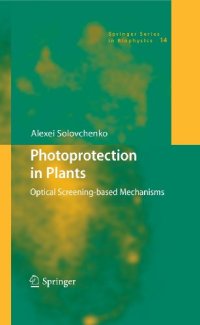
Ebook: Photoprotection in Plants: Optical Screening-based Mechanisms
Author: Alexei Solovchenko (auth.)
- Genre: Mathematics // Mathematicsematical Physics
- Tags: Plant Biochemistry, Biophysics and Biological Physics, Plant Physiology
- Series: Springer Series in Biophysics 14
- Year: 2010
- Publisher: Springer-Verlag Berlin Heidelberg
- Edition: 1
- Language: English
- pdf
Optical screening of excessive and potentially harmful solar radiation is an important photoprotective mechanism, though it has received much less attention in comparison with other systems preventing photooxidative damage to photoautotrophic organisms. This photoprotection in the form of screening appears to be especially important for juvenile and senescing plants as well as under environmental stresses—i.e. in situations where the efficiency of enzymatic ROS elimination, DNA repair and other ‘classical’ photoprotective systems could be impaired. This book represents an attempt to develop an integral view of optical screening-based photoprotection in microalgae and higher plants. Towards this end, the key groups of pigments involved in the screening of ultraviolet and visible components of solar radiation in microalgae and higher plants, and the patterns of their accumulation and distribution within plant cells and tissues, are described. Special attention is paid to the manifestations of screening pigment accumulation in the optical spectra of plants. It is also demonstrated that understanding these effects and their relationships to screening pigments’ makeup and spectroscopy in plants provides valuable insights into the state of plants’ long-term photoacclimation, as well as ample opportunities for the non-destructive quantification of screening pigments and the assessment of the efficiency of photoprotection providing by these pigments in situ.
Optical screening of excessive and potentially harmful solar radiation is an important photoprotective mechanism, though it has received much less attention in comparison with other systems preventing photooxidative damage to photoautotrophic organisms. This photoprotection in the form of screening appears to be especially important for juvenile and senescing plants as well as under environmental stresses—i.e. in situations where the efficiency of enzymatic ROS elimination, DNA repair and other ‘classical’ photoprotective systems could be impaired. This book represents an attempt to develop an integral view of optical screening-based photoprotection in microalgae and higher plants. Towards this end, the key groups of pigments involved in the screening of ultraviolet and visible components of solar radiation in microalgae and higher plants, and the patterns of their accumulation and distribution within plant cells and tissues, are described. Special attention is paid to the manifestations of screening pigment accumulation in the optical spectra of plants. It is also demonstrated that understanding these effects and their relationships to screening pigments’ makeup and spectroscopy in plants provides valuable insights into the state of plants’ long-term photoacclimation, as well as ample opportunities for the non-destructive quantification of screening pigments and the assessment of the efficiency of photoprotection providing by these pigments in situ.